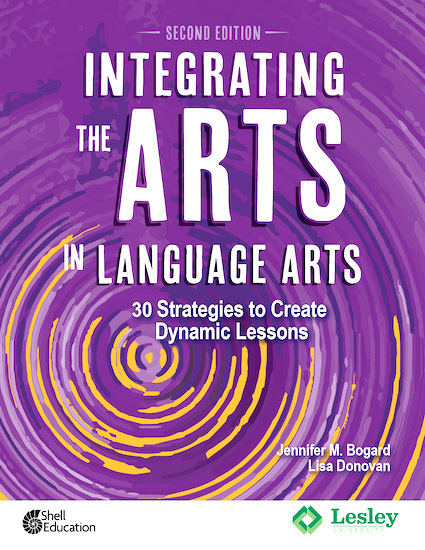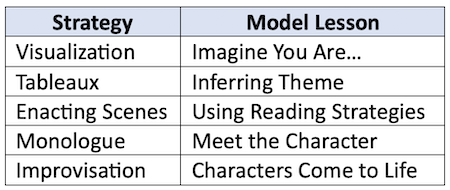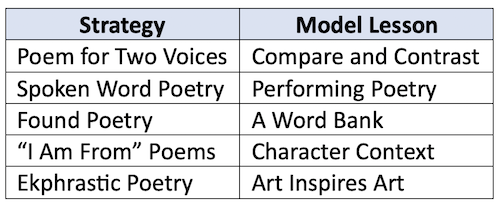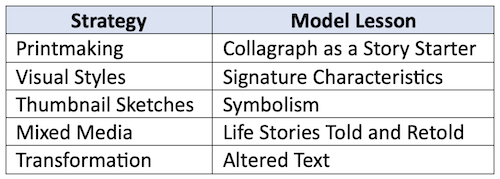Dynamic Strategies to Integrate Arts into ELA
Integrating the Arts in Language Arts: 30 Strategies to Create Dynamic Lessons Second Edition
By Jennifer M. Bogard and Lisa Donovan
(Shell Education, 2022 – Learn more)
Reviewed by Anne Anderson

In the introduction the authors issue an invitation to readers “to see for yourself” how these strategies can enrich the lives of students. I accepted that invitation!

Storytelling
Busy teachers will appreciate how the book is organized. Each of the six modalities includes five strategies along with model lessons suggesting ways to integrate that art form into the language arts class. For example, in the Storytelling chapter:
Within each suggested strategy, readers find an overview, the standards involved, and a list of materials needed. Then we find a suggested procedure for presenting the model lesson, complete with Planning Questions and Discussion Questions. As I delved into the book, I began to see multiple opportunities to engage students and strengthen academic achievement.
One of my favorite activities is from Storytelling is The Untold Story in which “students explore how stories are focused on main characters and how the perspectives of other characters are often minimized or left out as a result.” (p.36) While the specific idea for Grades 6-8 is excellent, I found myself drawn to the K-2 idea. The authors suggest using the poem “Bleezer’s Ice Cream” by Jack Prelutsky and inviting “students to tell the story of a character who visits Bleezer’s ice cream store and has to decide which flavor to sample and why.” (p.38)
Drama
Within the Drama section, I found these strategies and model lessons.
I confess: I did not have one favorite here – I had five favorites! My top favorite is Enacting Scenes since all the specific grade-level ideas are engaging. In addition to Language Arts skills, I also saw these lessons as opportunities to address employmentability related skills such as teamwork, problem-solving, and resourcefulness.
Poetry
In the Poetry section, students “are invited to put words together in fresh new ways, drawing on evocative language and the playful juxtaposition of ideas, and create images through words as they write poems about concepts in language arts.” (p. 91)
Another confession: I had never heard of ekphrastic poetry. Ekphrastic poetry finds inspiration in a work of art. The authors point out that although “it is most often associated with visual art, it works well with other art forms such as music, dance, and theater.” (p. 93) This activity might include a field trip (in person or virtually) to a nearby art gallery or museum. I was delighted to discover numerous ekphrastic poetry samples inspired by The Grandmother by Honore Daumier.
Music
Don’t skip the Music activities just because you aren’t a musician. After reviewing the strategies and model lessons, you may be surprised! “The musical strategies provided here will focus on deepening knowledge of listening—which is a fundamental musical skill—as well as deepening knowledge of and skills in language arts.” (p.137) Bogard and Donovan assure readers no musical training is required.
With the Found Sounds strategy, students explore the sounds they hear while on a listening walk. After sorting their sounds into categories (e.g., pleasant, unpleasant, animals, traffic, etc.), students represent the sounds in a poem, story, or list. This activity is the perfect launch for Soundscapes.
Soundscapes is defined as “an acoustic environment consisting of events heard, rather than objects seen.” (p.145) The goal, to recreate a scene using only sounds, “involves careful analysis, revising, critical thinking, and problem-solving skills.” (p.145) The specific grade-level ideas range from picture books to Shakespeare. What could be more engaging than playing music from Star Wars to demonstrate how mood and character are presented?
Visual Arts
In exploring Visual Arts, students have the opportunity to “communicate nuances that words cannot.” (p.171) In this chapter I discovered numerous opportunities to build creativity, critical thinking, and communication skills with these strategies and model lessons.
Adding Creative Movement to a language arts class enhances and reinforces learning. This closing chapter has a different structure along with additional details for implementation.
- Answer Me in Movement
- Movement Strings
- Progressions
- Sensory Movement
- Choreographic Structure
Think of delivering this instruction in two parts: a how-to model lesson for each strategy followed by an implementation lesson of the strategies using a single piece of text. The end result is a combination of all strategies into one choreographed piece known as a suite.
Note: The authors suggest presenting the strategies sequentially; however, the strategies can be presented as stand-alone lessons.
A treasure trove for your classroom
I am glad I accepted Bogard and Donovan’s invitation to “see for myself.” What I saw was a treasure trove of instructional ideas with thorough explanations for each activity, key vocabulary, recommended resources, and additional support exclusive to that art form. The authors support this approach with current research throughout the book.
Now, I extend an invitation to you to “see for yourself” what is inside Integrating the Arts in Language Arts: 30 Strategies to Create Dynamic Lessons.
Anne Anderson always knew she wanted to be a teacher. She graduated from East Texas Baptist University with an English major and History minor and did graduate work at Louisiana State University and Louisiana Tech University. After teaching 8th graders for 24 years, Anne served as a content coach. Since retiring in 2011, Anne has worked as an educational consultant, presenting at national conferences and onsite trainings for public and private schools.
Calendar Celebrations: September, October, November is part of Anne Anderson’s trilogy on quick, engaging activities and resources for months of the school year. (For MiddleWeb she wrote about back to school and fall resources here.) Anne has also published articles in IDEAS Plus and Voices from the Middle, publications of the National Council of Teachers of English. She is a frequent reviewer of professional books for MiddleWeb.com.









































